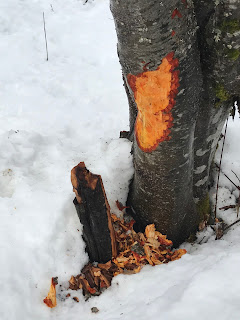The Dreadful Snowshoeing Trip
 |
| Pictured: Hannah Zaini, Me, Katie Rupp (I forgot who took the photo, sorry!) |
Even though the morning started out sitting in the car and driving back and fourth to two different destinations, just to go back to our original destination in the pouring rain was a lot to handle- the trip ended up becoming interesting and a story to tell later on.
We went February 2nd, left the campus at 9, but we didn't get to actually snowshoe until 1:30 on Gold Creek in Snoqualmie pass.
 |
| Figure 1 |
 |
| Figure 2 |
Animal tracking is very beneficial to understand how animals survive in different environments and how they acclimate to the weather- especially in Washington's bi-polar craziness. Tracking is also used to see what different kinds of organisms and animals live in that particular area- which also helps them understand what they eating and if there is anything that is harming those animals. I-90 respects its wildlife very well and efficiently as well. This goes for the wildlife bridge that they are building over the freeway- where the animals can safely cross the freeway in an alternate route instead of the dangerous way.
The I-90 Wildlife Bridges Coalition is the heart and soul of building the wildlife crossing bridge. While driving to Thorp to look if we can show shoe there, we saw the first one that was built for the animals. It's very important to not only make the roads safer on the pass which is vital, but it is also important for the animals as well. If the animals cannot cross the interstate, they won't be able to find new food, mate, migrate, or try to get away from predators. The I-90 Wildlife Bridges Coalition will hopefully be done soon in 2019. As a frequent driver on I-90 to go to Spokane, this will definitely make a difference. Many people go really fast on the pass and if an animal ever crossed, I don't think they'll be able to stop fast enough. The rebuild will not only benefit the people, but wildlife too.
I've never been snow-shoeing before, but this was a really great first experience and it was one where I definitely will go back again. I never knew wildlife tracking would be so important to the society, but when you think about it, it make sense. Before there was technology, there were native people that were able to hunt by developing the skills to track animals and hunt. Wildlife tracking has been beneficial for providing food and supplies to humans. Later on, it has also been beneficial to understand what animals are native to the area and understanding what is needed to provide a good environment for them where the wildlife can thrive and nourish. With tracking prints, we understand how animals work, what they eat, and how they migrate.

Thank you for your post. I enjoyed finding out that your trip was not dreadful, however; the word dreadful drew me to your post because I wanted to find out why. I have never seen squirrel tracks so seeing that was educational. I also loved learning about the wildlife coalition bridge project.
ReplyDeleteYour post is awesome, and I'm glad you had fun even though the weather was a little gloomy. I enjoyed your pictures, especially the one where the beavers were gnawing on the wood. I agree that it's important to learn how to track wildlife, I can come in handy when camping. In camping, you would know which animals are present in you vicinity so you could prep yourself of harming each other. In addition, scientist could observed which animals are populated in a certain area and like you said are effect by the environment. Lastly, I think it's amazing that a section of the interstate is building a bridge for wildlife; animals benefit our ecosystem in many ways.
ReplyDelete